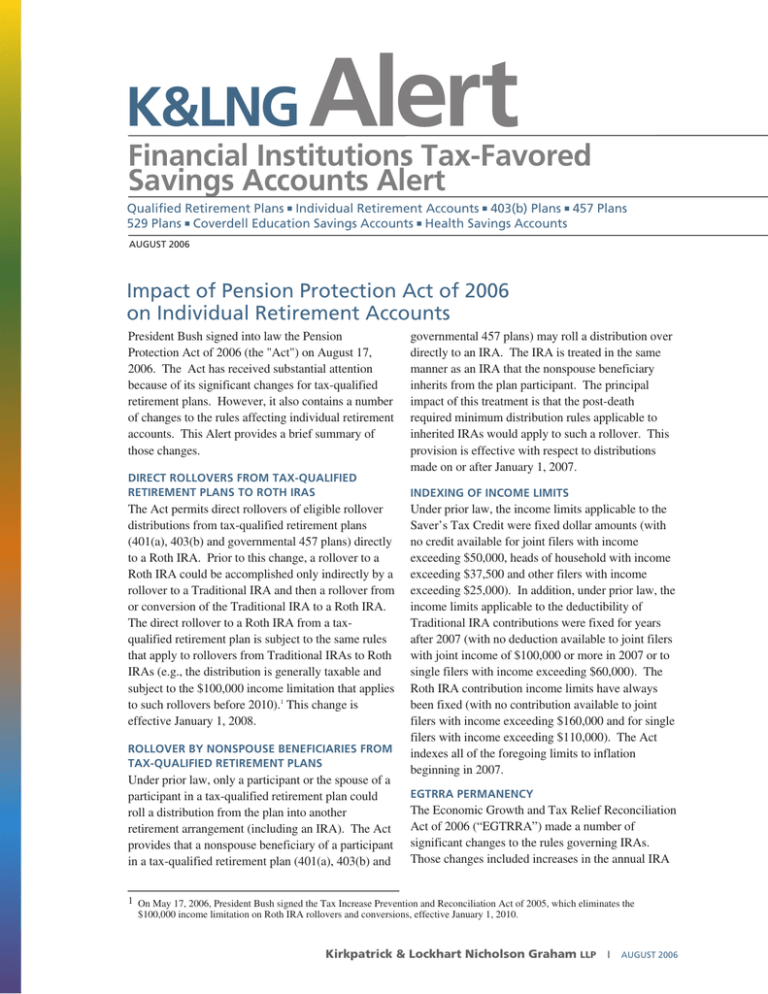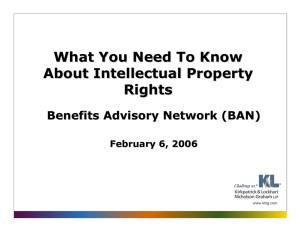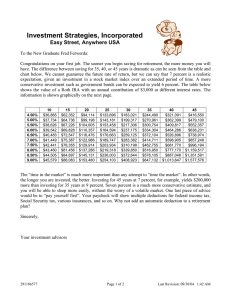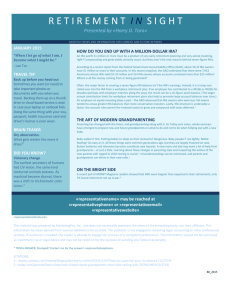
K&LNG
Alert
Financial Institutions Tax-Favored
Savings Accounts Alert
Qualified Retirement Plans ■ Individual Retirement Accounts ■ 403(b) Plans ■ 457 Plans
529 Plans ■ Coverdell Education Savings Accounts ■ Health Savings Accounts
AUGUST 2006
Impact of Pension Protection Act of 2006
on Individual Retirement Accounts
President Bush signed into law the Pension
Protection Act of 2006 (the "Act") on August 17,
2006. The Act has received substantial attention
because of its significant changes for tax-qualified
retirement plans. However, it also contains a number
of changes to the rules affecting individual retirement
accounts. This Alert provides a brief summary of
those changes.
DIRECT ROLLOVERS FROM TAX-QUALIFIED
RETIREMENT PLANS TO ROTH IRAS
The Act permits direct rollovers of eligible rollover
distributions from tax-qualified retirement plans
(401(a), 403(b) and governmental 457 plans) directly
to a Roth IRA. Prior to this change, a rollover to a
Roth IRA could be accomplished only indirectly by a
rollover to a Traditional IRA and then a rollover from
or conversion of the Traditional IRA to a Roth IRA.
The direct rollover to a Roth IRA from a taxqualified retirement plan is subject to the same rules
that apply to rollovers from Traditional IRAs to Roth
IRAs (e.g., the distribution is generally taxable and
subject to the $100,000 income limitation that applies
to such rollovers before 2010).1 This change is
effective January 1, 2008.
ROLLOVER BY NONSPOUSE BENEFICIARIES FROM
TAX-QUALIFIED RETIREMENT PLANS
Under prior law, only a participant or the spouse of a
participant in a tax-qualified retirement plan could
roll a distribution from the plan into another
retirement arrangement (including an IRA). The Act
provides that a nonspouse beneficiary of a participant
in a tax-qualified retirement plan (401(a), 403(b) and
governmental 457 plans) may roll a distribution over
directly to an IRA. The IRA is treated in the same
manner as an IRA that the nonspouse beneficiary
inherits from the plan participant. The principal
impact of this treatment is that the post-death
required minimum distribution rules applicable to
inherited IRAs would apply to such a rollover. This
provision is effective with respect to distributions
made on or after January 1, 2007.
INDEXING OF INCOME LIMITS
Under prior law, the income limits applicable to the
Saver’s Tax Credit were fixed dollar amounts (with
no credit available for joint filers with income
exceeding $50,000, heads of household with income
exceeding $37,500 and other filers with income
exceeding $25,000). In addition, under prior law, the
income limits applicable to the deductibility of
Traditional IRA contributions were fixed for years
after 2007 (with no deduction available to joint filers
with joint income of $100,000 or more in 2007 or to
single filers with income exceeding $60,000). The
Roth IRA contribution income limits have always
been fixed (with no contribution available to joint
filers with income exceeding $160,000 and for single
filers with income exceeding $110,000). The Act
indexes all of the foregoing limits to inflation
beginning in 2007.
EGTRRA PERMANENCY
The Economic Growth and Tax Relief Reconciliation
Act of 2006 (“EGTRRA”) made a number of
significant changes to the rules governing IRAs.
Those changes included increases in the annual IRA
1 On May 17, 2006, President Bush signed the Tax Increase Prevention and Reconciliation Act of 2005, which eliminates the
$100,000 income limitation on Roth IRA rollovers and conversions, effective January 1, 2010.
Kirkpatrick & Lockhart Nicholson Graham LLP |
AUGUST 2006
contribution limits (including catch-up
contributions), an expansion of the rules relating to
rollovers of distributions between tax-qualified
retirement plans and IRAs, Deemed IRAs in taxqualified retirement plans, automatic IRA rollovers
of mandatory distributions from tax-qualified
retirement plans and the so-called “Saver’s Tax
Credit” applicable to contributions to IRAs and taxqualified retirement plans by low-income
individuals. The changes enacted by EGTRRA were
scheduled to expire on December 31, 2010. The Act
repeals this expiration date and makes the EGTRRA
changes permanent.
DISTRIBUTIONS TO MILITARY RESERVISTS
CALLED TO ACTIVE DUTY
The Act provides that the 10% early withdrawal
excise tax penalty that generally applies to IRA
distributions made before age 59-1/2 does not apply
to a distribution made to an IRA owner during a
period of active military duty, if the IRA owner was
called to such duty from reserve duty and the active
duty is for an indefinite period or a period of 180
days or longer. The IRA owner may repay any such
distribution during the two-year period beginning on
the day after the end of his or her active military duty
(or, if later, August 17, 2006). Those repayments do
not count against the IRA annual contribution limits.
This provision applies to individuals called to active
duty after September 11, 2001, and before December
31, 2007.
INCOME EXCLUSION FOR CHARITABLE
DISTRIBUTIONS FROM IRAS AFTER AGE 70-1/2
The Act excludes from an IRA owner’s gross income
up to $100,000 of otherwise taxable distributions
from the IRA that are made directly to a charitable
organization after the IRA owner attains age 70-1/2.
The provision applies to otherwise taxable
distributions from both Traditional IRAs as well as
Roth IRAs and only to the extent that the distribution
would otherwise be deductible as a charitable
contribution (determined without regard to the
generally applicable percentage limitations on such
deductions). A distribution that is excluded from
gross income under this provision does not count
against the IRA owner’s charitable contribution
deduction. This provision is effective for
distributions made from January 1, 2006 through
December 31, 2007.
2
DIRECT DEPOSIT OF TAX REFUNDS
The Act provides that the federal government may, at
the direction of an IRA owner, deposit any federal
income tax refund (including refunds attributable to
the Saver’s Tax Credit) directly to the IRA owner’s
IRA. Any such deposit would be treated as a
contribution and count against the applicable annual
contribution limit. This change is effective
January 1, 2007.
ADDITIONAL CONTRIBUTIONS FOR
PARTICIPANTS IN CERTAIN 401(K) PLANS
SPONSORED BY BANKRUPT COMPANIES
An individual who participates in a 401(k) plan in
which at least 50% of the participant’s contributions
are matched by the employer with employer stock
may contribute an additional $3,000 to his or her
IRA if (i) in the year preceding the year of the
contribution, the employer (or a controlling company
of the employer) was a debtor in bankruptcy, or
(ii) the employer or any other person was subject to
an indictment or conviction resulting from business
transactions related to the bankruptcy of the
employer (or a controlling company of the
employer). The IRA owner must have been a
participant in the plan on the date that is six months
before the bankruptcy case was filed. An IRA owner
who elects to make additional contributions under
this rule may not make catch-up contributions. This
provision is effective January 1, 2007, and expires
December 31, 2009.
PROHIBITED TRANSACTION EXEMPTIONS
The Act includes a number of provisions relating to
the prohibited transaction rules of ERISA and the
Internal Revenue Code. These provisions will most
significantly impact tax-qualified retirement plans
and their service providers, but they also apply to
transactions involving IRAs. K&LNG Alerts
describing these new prohibited transaction rules,
including changes to the plan asset rules applicable
to unregistered investment vehicles and a new
investment advice prohibited transaction exemption,
can be found at:
http://www.klng.com/newsstand/CustomSearch.
aspx?KeywordPhrase=PPA0123.
* * * * *
Kirkpatrick & Lockhart Nicholson Graham
LLP
| AUGUST 2006
IRA sponsors, custodians and trustees will need to
update their IRA disclosure statements to reflect
these new rules. In addition, pending anticipated
future guidance from the Internal Revenue Service,
IRA trust and custodial agreements may need to be
revised (regardless of whether those agreements take
the form of the model Internal Revenue Service trust
and custodial agreements or prototype agreements).
If you would like more information regarding the
matters discussed in this Alert, please contact one of
the following lawyers listed below:
Michael A. Hart
mhart@klng.com
412.355.6211
Catherine S. Bardsley
cbardsley@klng.com
202.778.9289
Our Financial Institution Tax-Favored Savings Accounts practice is part of our Employee Benefit
Plans/ERISA practice. If you have any questions or would like more information about K&LNG’s Employee
Benefit Plans/ERISA practice group, please contact one of the Compensation and Benefit lawyers listed
below.
PITT SBU RGH
B O ST O N
Charles A. Grace
Peter J. Marathas, Jr.
Stephen E. Moore
617.951.9073
617.951.9072
617.951.9191
cgrace@klng.com
pmarathas@klng.com
smoore@klng.com
Alexandra C. Sparling
310.552.5563
asparling@klng.com
William P. Wade
310.552.5071
wwade@klng.com
L O S A NG E LE S
412.355.8600
412.355.6211
412.355.6454
412.355.6536
412.355.8676
412.355.8375
wcullen@klng.com
mhart@klng.com
rlauver@klng.com
csmith@klng.com
rwood@klng.com
dellis@klng.com
202.778.9289
202.778.9887
202.778.9373
202.778.9024
202.778.9210
cbardsley@klng.com
dpickle@klng.com
william.schmidt@klng.com
lgalletto@klng.com
bmcparland@klng.com
W AS H IN GTO N, D C
NEW YO RK
David E. Morse
William T. Cullen
Michael A. Hart
J. Richard Lauver
Charles R. Smith
Richard E. Wood
Douglas J. Ellis
212.536.3998
dmorse@klng.com
Catherine S. Bardsley
David E. Pickle
William A. Schmidt
Lori G. Galletto
Brendan S. McParland
www.klng.com
BOSTON • DALLAS • HARRISBURG • LONDON • LOS ANGELES • MIAMI • NEWARK • NEW YORK • PALO ALTO • PITTSBURGH • SAN FRANCISCO • WASHINGTON
Kirkpatrick & Lockhart Nicholson Graham (K&LNG) has approximately 1,000 lawyers and represents entrepreneurs, growth and middle market companies,
capital markets participants, and leading FORTUNE 100 and FTSE 100 global corporations nationally and internationally.
K&LNG is a combination of two limited liability partnerships, each named Kirkpatrick & Lockhart Nicholson Graham LLP, one qualified in Delaware, U.S.A. and
practicing from offices in Boston, Dallas, Harrisburg, Los Angeles, Miami, Newark, New York, Palo Alto, Pittsburgh, San Francisco and Washington and one
incorporated in England practicing from the London office.
This publication/newsletter is for informational purposes and does not contain or convey legal advice. The information herein should not be used or relied
upon in regard to any particular facts or circumstances without first consulting a lawyer.
Data Protection Act 1988—We may contact you from time to time with information on Kirkpatrick & Lockhart Nicholson Graham LLP seminars and with our
regular newsletters, which may be of interest to you. We will not provide your details to any third parties. Please e-mail london@klng.com if you would prefer
not to receive this information.
© 2006 KIRKPATRICK & LOCKHART NICHOLSON GRAHAM LLP. ALL RIGHTS RESERVED.
Kirkpatrick & Lockhart Nicholson Graham
LLP
|
AUGUST 2006






